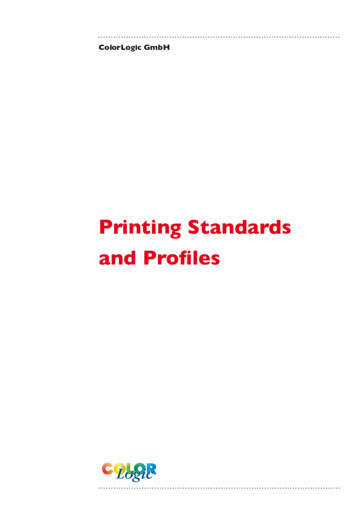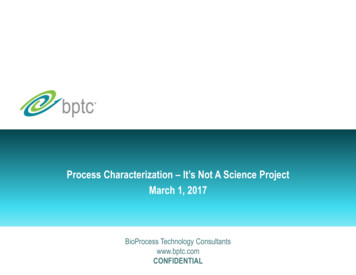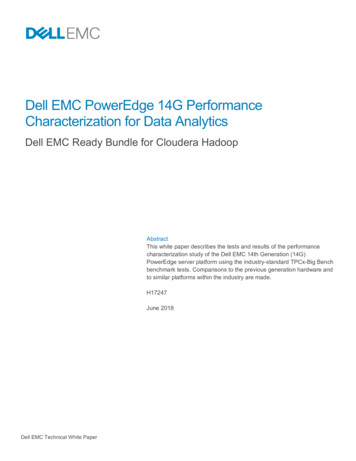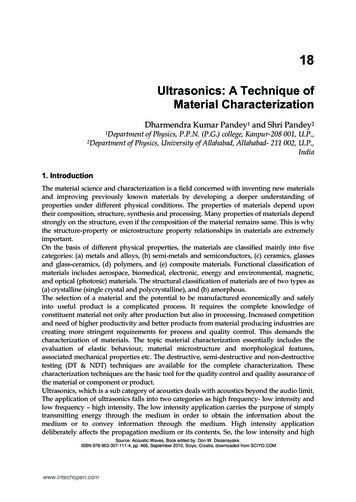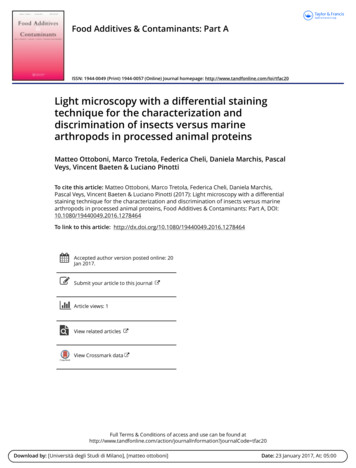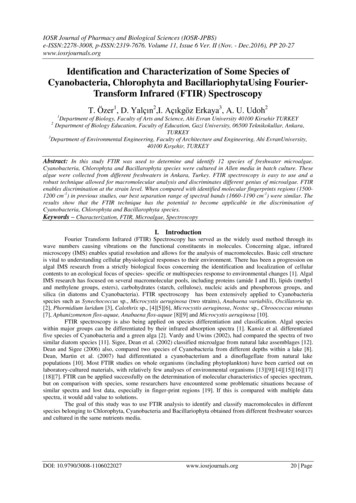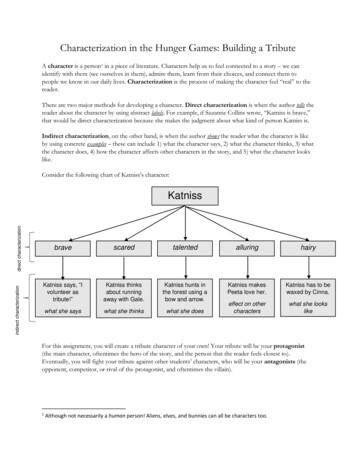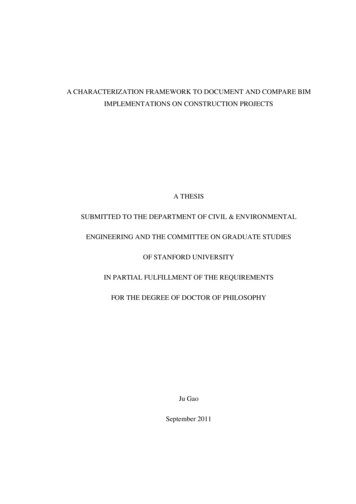
Transcription
A CHARACTERIZATION FRAMEWORK TO DOCUMENT AND COMPARE BIMIMPLEMENTATIONS ON CONSTRUCTION PROJECTSA THESISSUBMITTED TO THE DEPARTMENT OF CIVIL & ENVIRONMENTALENGINEERING AND THE COMMITTEE ON GRADUATE STUDIESOF STANFORD UNIVERSITYIN PARTIAL FULFILLMENT OF THE REQUIREMENTSFOR THE DEGREE OF DOCTOR OF PHILOSOPHYJu GaoSeptember 2011
2011 by Ju Gao. All Rights Reserved.Re-distributed by Stanford University under license with the author.This work is licensed under a Creative Commons AttributionNoncommercial 3.0 United States 3.0/us/This dissertation is online at: http://purl.stanford.edu/yj761rc6510ii
I certify that I have read this dissertation and that, in my opinion, it is fully adequatein scope and quality as a dissertation for the degree of Doctor of Philosophy.Martin Fischer, Primary AdviserI certify that I have read this dissertation and that, in my opinion, it is fully adequatein scope and quality as a dissertation for the degree of Doctor of Philosophy.John HaymakerI certify that I have read this dissertation and that, in my opinion, it is fully adequatein scope and quality as a dissertation for the degree of Doctor of Philosophy.John KunzApproved for the Stanford University Committee on Graduate Studies.Patricia J. Gumport, Vice Provost Graduate EducationThis signature page was generated electronically upon submission of this dissertation inelectronic format. An original signed hard copy of the signature page is on file inUniversity Archives.iii
ABSTRACTBuilding Information Modeling (BIM) is a new way of working and AEC professionalsand researchers are trying to understand its implementation and impacts. To develop thisunderstanding, one of the approaches is to study what happened on past projects that haveimplemented BIM and to synthesize the differences and commonalities. However, thecurrent BIM stories typically present fragmented project data that cannot capture BIMimplementations in a structured, sufficient, and consistent way. In addition, the currentlyavailable BIM guidelines lack validation by a large number of projects. Given theseshortcomings, AEC professionals and researchers cannot achieve knowledge that guidesthem towards well-defined, measurable, and monitored BIM implementations. Aframework to characterize BIM implementations is needed to link the broken chain “fromdata to knowledge”.Through case studies on 40 construction projects, this research provides a framework tocharacterize why, when, for whom, in what level of detail, with which tools, how, forhow much, and how well BIM implementations are done on projects. With thecharacterization framework, past projects can be documented sufficiently andconsistently so that BIM managers or BIM researchers can compare a group of BIMprojects to gain insight into how to maximize the benefits of BIM.The contribution of this research is a characterization framework that: Organizes project data of BIM implementations into categories, factors, andmeasures with an increasing levels of detail; Sufficiently and consistently captures why, when, for whom, at what level ofdetail, with which tools, how, for how much, and how well BIM implementationswere done on the 40 case projects; and Supports cross-project comparisons of BIM implementations to gain insights intoimplementation patterns (i.e., how to plan a BIM implementation to maximizebenefits).iv
ACKNOWLEDGEMENTSI dedicate this dissertation to my family – my mom and dad who have been giving me somuch love and support and have always encouraged me to follow my passion and live afulfilling life.My deepest gratitude goes to my advisor – Professor Martin Fischer. Martin has guidedme on the path of scholarship with patience, conscientiousness, and a sense of humor. Hisadvice, from research strategy to writing styles, has always been thoughtful and sharp.I thank my Ph.D. committee members – Dr. John Kunz (Executive Director of CIFE), Dr.John Haymaker (Founder at DPI), and Dr. Calvin Kam (Director of Industry Programs,CIFE) – for their insightful comments on my research.At Stanford University’s Center for Integrated Facility Engineering (CIFE), I enjoyed thechallenges and collaborations with my colleagues, including Tony Dong, Dr. VictorGane, Wendy Li, Dr. Reid Senescu, and many other wonderful colleagues. Special thanksalso go to Teddie Guenzer for all her administrative support.I thank CIFE and its member companies for the funding support in the Academic Years2004-2005, 2005-2006, and 2008-2009.I acknowledge the Technology Agency of Finland (Tekes) and Prof. Arto Kiviniemi forsupporting my case studies on the BIM implementations on projects in Finland.I wish to thank Tongji University and Prof. Guangbin Wang for supporting my casestudies on the BIM implementations on projects in China.In particular, I wish to thank those AEC professionals, researchers, and organizationswho participated in the case studies. Without their sharing of time and expertise, thisstudy would not have been possible. The list includes but is not limited to these people. Dr. Airaksine, Miimu (OptiPlan) Dr. Akbas, Ragip (Autodesk)v
Dr. Fox, Stephan (VTT) Mr. Hahl, Tuomo (Senate Properties) Dr. Hartmann, Timo (Twente University) Mr. Heikkilä, Sami (Skanska) Mr. Hietanen, Jiri (TUT) Mr. Hörkkö, Jukka (Skanska) Mr. Iso-Aho, Jyrki (A-KONSULTIT) Mr. Järvinen, Tero (Olof Granlund) Dr. Jongeling, Rogier (Luleå University of Technology) Ms. Karjalainen, Auli (Senate Properties) Dr. Khanzode, Atul (DPR Construction) Dr. Kim, Jonghoon (DPR Construction) Dr. Koo, Bonsang (then at Strategic Project Solutions) Mr. Kunz, Alex (then at Strategic Project Solutions) Mr. Laine, Tuomas (Olof Granlund) Dr. Laitinen, Jarmo (TUT) Ms. Liston, Kathleen (Liston Consulting) Mr. Lyu, Seungkoon (then at CIFE, Stanford University) Mr. Niemioja, Seppo (Innovarch) Dr. Staub-French, Sheryl (University of British Columbia) Ms. Suojoki, Anne (Skanska), Mr. Toivio, Teemu (JKMM) Mr. Tollefsen, Terje (Norwegian University of Science and Technology) Mr. Törrönen, Ari (NCC) Mr. Valjus, Juha (Finnmap Consulting) Mr. Zhou, Kai (China Steel Group - Central Southern China Design Institute)A final thanks is given to anyone that I may have missed in these acknowledgements.Your omission was purely unintentional.vi
TABLE OF CONTENTSABSTRACT. ivACKNOWLEDGEMENTS . vTABLE OF CONTENTS . viiTABLE OF TABLES . xTABLE OF FIGURES . xivCHAPTER 1 – INTRODUCTION: RESEARCH MOTIVATION AND READER’SGUIDE . 11.1 Research Motivation . 11.2 Reader’s Guide – Key Points of the Thesis . 2CHAPTER 2 – PRACTICAL POINTS OF DEPARTURE, INTUITION, ANDRESEARCH QUESTION . 72.1 Observed Problems . 72.2 Intuition . 192.3 Research Question and Scope Definition . 21CHAPTER 3 – THEORETICAL POINTS OF DEPARTURE . 243.1 Theoretical P.O.Ds that Demonstrate Why a Framework is Needed . 243.2 Theoretical P.O.Ds that Demonstrate the Observed Problems in Practice . 263.3 Theoretical P.O.Ds that Illustrate BIM-related Frameworks and Guidelines . 293.4 Theoretical P.O.Ds for Developing the Characterization Framework . 37vii
CHAPTER 4 – RESEARCH METHOEDS. 444.1 Criteria for Research Methods. 444.2 Multiple Case Studies . 444.3 Grounded Theory. 454.4 Techniques to Improve the Methodological Rigor . 46CHAPTER 5 – RESEARCH TASKS . 505.1 Three Phases of Case Studies . 505.2 Data Collection, Analysis, and Framework Development . 56CHAPTER 6 – RESEARCH RESULTS . 95CHAPTER 7 – RESEARCH CONTRIBUTION AND VALIDATION . 987.1 Requirements of a Good Characterization Framework for BIM Implementationsand an Overview of Validation Metrics and Methods. 987.2 Validation Results . 1027.2.1Validating the documentation power of the characterization framework forBIM implementations. 1027.2.2Validating the capability of the characterization framework for BIMimplementations to support the comparison of BIM implementations acrossprojects and gain insights on implementation patterns . 1087.2.3Validating the methodological rigor of the characterization framework forBIM implementations. 135CHAPTER 8 – SUMMARY AND DISCUSSION . 139viii
8.1 Practical Significance of the Framework. 1398.2 Intellectual Merits of the Framework . 1408.3 Future Work. 141REFERENCES . 144APPENDIX A: GLOSSARY. 157ix
TABLE OF TABLESTable 2-1: Examples of decisions to be made in setting up a BIM implementation . 7Table 2-2: Examples of decisions in planning a BIM implementation that maximizes thebenefits on a project . 8Table 2-3: By learning BIM implementations on individual projects, AEC professionalsobtain bits and pieces of unstructured and fragmented information that capturesthe ad-hoc experience pertinent to one or a few factors in setting up a BIMimplementation. . 9Table 2-4: It is difficult to compare BIM implementations across the 12 cases presentedat the IAI conference because presented project data are neither sufficient norconsistent in capturing the factors professionals need to know to set up animplementation and understand the benefits realized from the implementation. 13Table 2-5: A list of guidelines for BIM implementations. 18Table 2-6: The research scope of the characterization framework for BIM . 23Table 3-1: Theoretical points of departure (P.O.Ds) that demonstrate why a framework isneeded . 25Table 3-2: An overview of twenty-two papers that document BIM implementations onindividual projects . 27Table 3-3: It is difficult to compare the 12 individual cases on using 4D models forconstruction sequencing because these cases are neither sufficient nor consistentin capturing the factors in setting up an implementation and benefits realizedfrom it. 28Table 3-4: An overview of BIM related guidelines and frameworks . 32x
Table 3-5: A comparative analysis of BIM related frameworks and guidelines that aretargeted at the industry level . 34Table 3-6: A comparative analysis of BIM related frameworks and guidelines that aretargeted at the enterprise level . 35Table 3-7: A comparative analysis of BIM related frameworks and guidelines that aretargeted at the project level . 36Table 3-8: Theoretical points of departure (P.O.Ds) that are stepping stones towardsdeveloping the characterization framework for BIM implementation . 37Table 3-9: Labeling the measures in Framework-1 . 41Table 4-1: Five techniques the researcher used to improve the methodological rigor indeveloping the characterization framework for BIM implementations . 47Table 5-1: An overview of the 21 projects in the first phase of case studies . 52Table 5-2: An overview of the 11 projects in the second phase of case studies . 55Table 5-3: An overview of the 8 projects in the third phase of case studies . 56Table 5-4: The question list for the first phase of case study interviews . 59Table 5-5: The additional questions in the revised interview questionnaire for the secondand third phase of case study interviews. 60Table 5-6: An example of case narrative for Case 6 (Baystreet Retail Complex). 63Table 5-7: An example showing how the measures are replicated across cases inFramework-3 . 65Table 5-8: An example showing the process of discovering new measures and factors . 69xi
Table 5-9: Factors and measures found or revised after using Framework-1 to document21 case projects . 70Table 5-10: Framework-2 (The text in blue indicates the factors and measures that arenewly found or revised. The bullets are the descriptive features for a particularmeasure.) . 76Table 5-11: Factors and measures found or revised after using Framework-2 to document11 case projects . 84Table 5-12: Framework-3 (The text in blue indicates the factors and measures that arenewly found or revised for Framework-1; and the text in red indicates thefactors and measures that are newly found or revised for Framework-2. Thebullets are the descriptive features for a particular measure.) . 86Table 5-13: Factors and measures found or revised after using Framework-3 to document8 case projects . 94Table 6-1: A characterization framework to document BIM implementations onconstruction projects . 96Table 7-1: Validation metrics and methods for the characterization framework for BIMimplementations . 101Table 7-2: Calculating the sufficiency of the three versions of the characterizationframework for BIM implementations . 104Table 7-3: Examples of calculating the consistency (occurrence) of measures across the40 cases . 105Table 7-4: Calculating the consistency of the characterization framework for BIMimplementations . 106Table 7-5: Factors and measures used to develop crosswalk 1 . 109xii
Table 7-6: Crosswalk 1 links BIM uses to the corresponding impacts on product, process,and organization and the related benefits to project stakeholders. (The text initalic indicates case examples which are listed in Table 5-1, Table 5-2, andTable 5-3.) . 111Table 7-7: Factors and measures used to develop crosswalk 2 . 117Table 7-8: Crosswalk 2 links BIM uses with the impacts on product, organization, andprocess along the project timeline. 118Table 7-9: Factors and measures used to develop crosswalk 3 . 124Table 7-10: Crosswalk 3 links the key stakeholders’ roles in the BIM process with thebenefits to them as individual stakeholders . 125Table 7-11: Factors and measures used to develop crosswalk 2 . 130Table 7-12: Crosswalk 4 (part II) links the timing of developing the level of detail in BIMwith the corresponding benefits. . 134Table 7-13: A summary of the validation results. 138Table 8-1: Implementation patterns confirm or adjust the general beliefs about BIMimplementations . 140xiii
TABLE OF FIGURESFigure 2-1: Individual BIM stories only provide unstructured and fragmented capture ofBIM implementations and cannot help AEC professionals how to set up a BIMimplementation consistently. . 12Figure 2-2: Comparing BIM stories with insufficient and inconsistent project data tocapture BIM implementations cannot help AEC professionals understand theimplementation patterns (i.e., how to set up a BIM implementation to maximizebenefits). 15Figure 2-3: The “data to knowledge” chain is broken without a formalized framework. 16Figure 2-4: A formalized framework is an indispensable step in linking the broken chainof “data to knowledge.” . 20Figure 3-1: The structure of Framework-1 . 38Figure 3-2: Labeling the categories in Framework-1 . 39Figure 3-3: Labeling the factors in Framework-1 . 40Figure 5-1: Three phases of case studies for the development of the characterizationframework for BIM implementations . 50Figure 5-2: Research activities and deliverables involved in data collection, analysis, andframework development . 58Figure 7-1: Requirements of a good characterization framework for BIMimplementations . 99Figure 7-2: Overview map of the characterization framework for BIM implementations. 103xiv
Figure 7-3: Three levels (high, medium, and low) of occurrence of the measures in theframework . 107Figure 7-4: The trend line correlates the number of model uses to the number of benefitsfor the 40 cases (each case is represented by a dot). . 116Figure 7-5: The number of benefits of BIM to the key project stakeholders in the “ownerleading” situations . 127Figure 7-6: The number of benefits of BIM to the key project stakeholders in the “GCleading” situations . 128Figure 7-7: The number of benefits of BIM to the key project stakeholders in the“designer leading” situations . 129Figure 7-8: Crosswalk 4 (part I) links the level of detail in BIM with the timing of BIM. 131Figure 7-9: Framework applied to different project types, delivery methods, and sizes 135xv
CHAPTER 1 – INTRODUCTION: RESEARCH MOTIVATION AND READER’SGUIDETeicholz (2004) suggests that the introduction of 3D object-based CAD is one of the mostimportant new approaches to construction productivity improvement to allow improveddesign, team collaboration, construction bidding, planning and execution, and real ownervalue at all stages of a project’s life cycle. Despite this vision, few project teams availthemselves of the continued and widespread use of building information modeling1(BIM) to the extent possible and economical. One challenge of crossing the “chasm”(Moore 1999) from “early adopters” (a few visionaries) to “early majority” (mostpragmatists) lies in the lack of concrete and formal understanding of implementations andimpacts of BIM on projects. To develop this understanding, one of the approaches is tostudy what happened on past projects that have implemented BIM and to synthesize thedifferences and commonalities.The objective of the research is to provide a framework to characterize why, when, forwhom, at what level of detail, with which tools, how, for how much, and how well BIMimplementations are done on projects. With the characterization framework, past projectscan be documented sufficiently and consistently so that BIM managers or BIMresearchers can compare a group of BIM projects to gain insight into how to maximizethe benefits of BIM.1.1Research MotivationThe idea of this research started from the researcher’s experience visiting Finland,Norway, the Netherlands, India, and China. The researcher talked to many AECprofessionals and learned their stories in the world of virtual design and construction. Theresearcher also attended conferences and workshops where AEC practitioners presented1The definitions of the terms underlined and formatted in bold and italic are in Appendix A.1
their visions, experiences, and beliefs. While it was fascinating to learn about thesestories, it quickly became overwhelming. Can BIM professionals and researchers puttogether these anecdotes, compare BIM implementations across different projects, andunderstand them collectively? This frustration provided the motivation for the researchefforts presented here.1.2Reader’s Guide – Key Points of the ThesisThe contribution of the research is a characterization framework (as shown in Chapter 6 –Research Result) that: Organizes project data of BIM implementations into a classification scheme of 3categories, 14 factors, and 74 measures with an elaborating level of detail. Sufficiently and consistently captures:o why (building information models (BIM) uses),o when (timing of BIM),o for whom (stakeholders involvement),o at what level of detail (modeled data),o with which tools (BIM software),o how (BIM work flow),o for how much (effort and cost), ando how well (benefits) BIM implementations were done in 40 case projects. Supports cross-project comparisons of BIM implementations to gain insights intoimplementation patterns).The current BIM stories (as discussed in Chapter 2 – Practical Points of Departure) oftenpresent fragmented project data that cannot capture BIM implementations in a structured,sufficient, and consistent way. In addition, the currently available BIM frameworks andguidelines (as discussed in Chapter 3 – Theoretical Points of Departure) lack validationby a large number of real projects. From these two points, AEC professionals cannotachieve knowledge that guides them towards well-defined, measurable, and monitoredBIM implementations. To link the broken chain “from data to knowledge” (Ackoff2
1989), a framework (which characterizes BIM implementations sufficiently, consistently,and in a structured way) is needed to compare BIM implementations across projects andto facilitate the understanding of how to plan a BIM implementation to maximizebenefits.The quality of the characterization framework manifests itself in three aspects.1. A good framework has documentation power. Structured organization: The framework organizes the project data of BIMimplementations in a structured way; Sufficient and consistent capture: The framework captures the project data ofBIM implementations as sufficiently and consistently as needed forcomparing why, when, for whom, at what level of detail, with which tools,how, for how much, and how well BIM is implemented across differentprojects.2. A good framework supports the comparison of BIM implementations acrossprojects to gain insights on implementation patterns.3. A good framework has the methodological rigor that is embedded in researchdesign and data analysis. Generality: The framework should be applicable to a number of case projectswith variations in project type, size, delivery method, time period of designand construction, and project location. Validity: The validity of the framework depends on how well the frameworkreflects the BIM implementations which it intends to document.Validation studies (as discussed in Chapter 7 – Research Validation) show that thecharacterization framework for BIM implementations presented in this thesis: Enables the organization of a BIM implementation in a structured way. Facilitates the capture of a BIM implementation sufficiently and consistently.3
o Sufficient capture: The fewer new measures that have to be added to theframework as more case are carried out, the more confidence theresearcher can have that the framework is sufficiently developed. Afterthe study of BIM on 40 cases, the degree of saturation of the framework is100%. That is to say, within the scope of 40 case projects, the frameworkcaptures all the major characteristics related to why, when, for whom, atwhat level of detail, with which tools, how, for how much, and how wellBIM implementations are done.o Consistent capture: The more measures (related to factors, e.g., modeluses, etc.) occurred in 40 cases, the more confidence the researcher hasthat this framework is consistent. After applying the framework to 40 caseprojects, I found that: 1) 56% of the 74 measures are observed in more than 75% of the40 case projects; 2) 20% of the 74 measures are observed in 25% - 75% of the 40case projects; and 3) 24% of the 74 measures are observed in fewer than 25% of thecase projects. Supports the comparison of BIM implementations across projects to gaininsights on implementation patterns. The researcher found four significantimplementation patterns from documenting and comparing 40 case projects withthe framework.o The higher the number of BIM uses on a project, the higher the numberof benefits.o The earlier BIM is created and used, the more lasting the benefits ofBIM.o The benefits to each individual stakeholder and to the whole project teamare maximized when the key stakeholders are all involved in creating andusing BIM.4
o Projects that maximized benefits have created BIMs at the appropriatelevel of detail that matches a particular model use and is just in time withthe information available at different design and construction stages.In addition, the generality of the framework is demonstrated by being applied to a widespectrum of projects (40 cases) with variations in project type, size, delivery method andcontract, time period of design and construction, and project location.The validity of the framework is demonstrated by the use of four techniques in researchdesign (as discussed in Chapter 4 – Research Methods and Chapter 5 – Research Tasks). Ethnographic interviews: The interview questions became refined and morespecific over the course of data collection and
Building Information Modeling (BIM) is a new way of working and AEC professionals and researchers are trying to understand its implementation and impacts. To develop this . Table 5-12: Framework-3 (The text in blue indicates the factors and measures that are newly found or r

